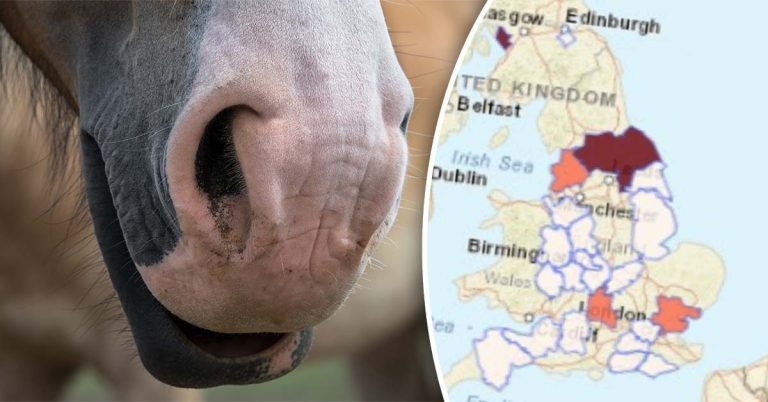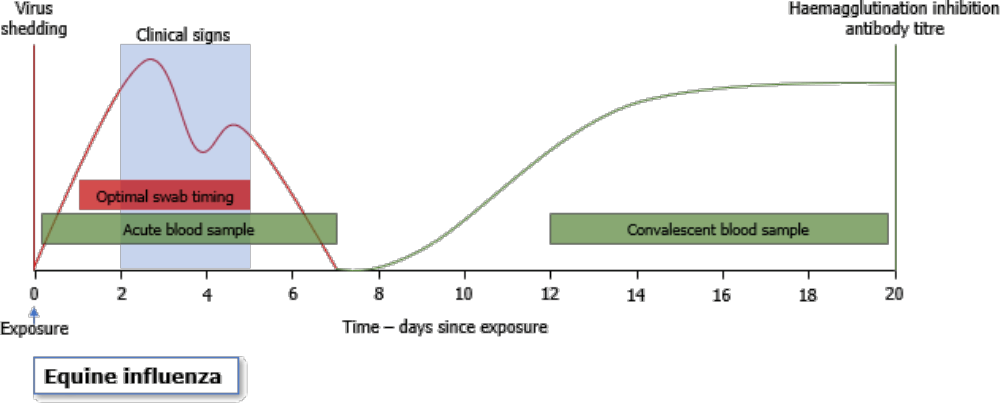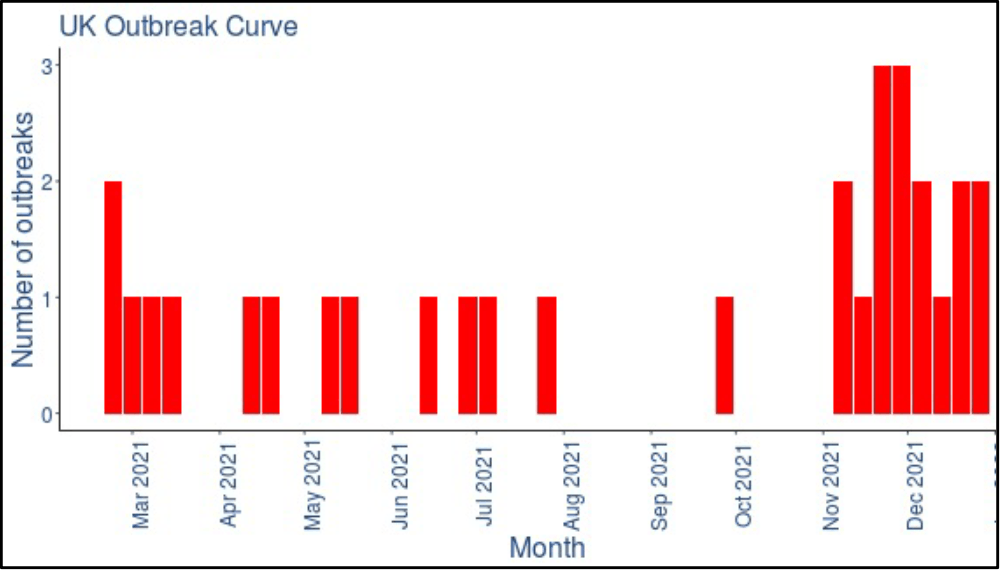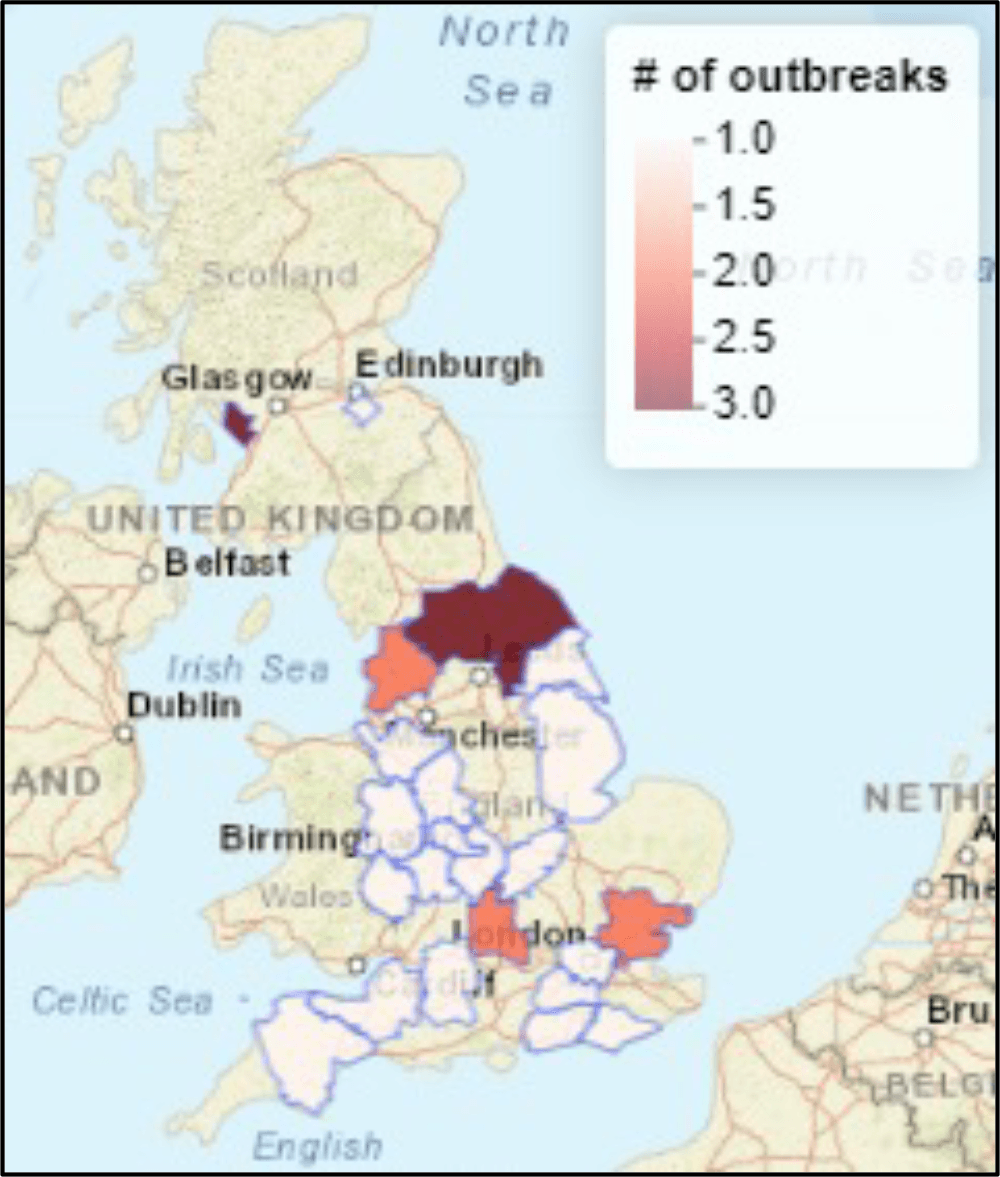23 Mar 2022
Equine flu – disease monitoring initiatives and surveillance in 2021
Equine influenza monitoring is still as important as ever in the UK and beyond. In this article, Fleur Whitlock and Richard Newton run the rule over who is now doing the monitoring and review surveillance findings from last year.

Equine infectious disease occurrences in the UK are monitored, and actions for their control and prevention are taken to optimise the health and welfare of the equine population, and to try to avoid interruptions to the equestrian calendar.
Equine Infectious Disease Surveillance (EIDS) is a newly established initiative, based at the Department of Veterinary Medicine at the University of Cambridge. EIDS encompasses the work previously conducted by the Epidemiology and Disease Surveillance group that was based at the AHT prior to its closure in 2020, and then hosted in the interim by the British Horseracing Authority, with funding continuing to be provided by the Thoroughbred racing and breeding industry. EIDS collaborates with equine industry stakeholders, including veterinary surgeons, vaccine manufacturers, commercial diagnostic laboratories, scientific researchers, equine competition regulatory bodies and government, and provides a disease control advice service for veterinary surgeons in the UK dealing with infectious disease outbreaks.
Several EIDS surveillance schemes exist to aid the identification and reporting of specific equine infectious disease occurrences, and the Horserace Betting Levy Board (HBLB) equine influenza testing scheme has been relaunched. The scheme funds PCR testing for suspected cases of equine influenza (EI) in Great Britain, with the laboratory testing conducted by Rossdales Laboratories in Newmarket.
Veterinary practices must be signed up to the scheme and samples need to be submitted with an appropriately completed scheme submission form.
Why use the HBLB-funded equine influenza surveillance scheme?
The scheme aims to assist treating vets in confirming if influenza virus is present on a premises, and in particular where there may be financial constraints on pursuing diagnostic testing. Importantly, the scheme is intended to also encourage testing in EI vaccinated horses with clinical respiratory signs, which may be suggestive of failure of vaccine efficacy.
A prompt diagnosis helps to ensure successful implementation of control measures for an infected premises, limiting spread of flu and its impacts on the industry, and welfare of horses. On confirmation of a positive diagnosis of EI, veterinary epidemiologists at EIDS will be able to assist equine vets with relevant outbreak advice. The scheme also enables epidemiological and virological information to be obtained that is vital to ensure preventive measures such as vaccination are optimally used in our horse population in Great Britain. Identifying risk factors for outbreaks can assist in the design of premises-specific biosecurity measures.
Virological analyses are conducted by HBLB-funded virologists at the University of Cambridge, to determine if current vaccines are likely to maintain levels of protection against the circulating field strains of flu virus. Anonymised data also contribute to further equine influenza research studies, ultimately intended to mitigate future major outbreaks of this highly infectious disease.
Which horses can be sampled on the HBLB-funded scheme?
- Any unvaccinated horse with typical influenza clinical signs, which may include combinations of coughing, nasal discharge, fever and inappetence.
- Vaccinated horses with clinical respiratory signs, which may, though, be milder than those seen in unvaccinated animals.
Which samples are covered for free PCR testing on the HBLB scheme?
- Nasopharyngeal swabs, ideally taken within five days of clinical signs first being noted (Figure 1).
Equine vets are encouraged to sample the most recently affected animal, or several cases, to optimise the chance of confirming a diagnosis of EI. This is because horses in the acute phase of infection are most likely to be shedding virus and, therefore, be found to be positive for EI by PCR.
Once a diagnosis has been reached for a particular premises, if vaccinated animals go on to demonstrate clinical signs, we strongly encourage that they also be sampled through this scheme.

Influenza surveillance in Great Britain
For a case or outbreak of EI to reach the reporting stage, a number of steps must be completed. These include keepers identifying an animal is sick and contacting the vet, cases being seen by a vet, diagnostic samples being taken and submitted to the laboratory for diagnosis, EIDS being informed, and anonymised data being shared through disease reporting platforms.
In addition to the HBLB-funded equine influenza surveillance scheme, EIDS has a surveillance network that includes all the commercial diagnostic laboratories in Great Britain that conduct agent detection testing for EI. Laboratories and referring veterinary surgeons are encouraged to share anonymous outbreak information with EIDS, and viral isolates for further analysis – forms for these submissions are available under the “Forms and Resources” tab on the EIDS website.
The collating and sharing of anonymised disease information is at the core of EIDS’ work, and EIDS oversee the International Collating Centre (ICC), an international disease reporting platform, for real-time reporting of disease occurrences, which is supported by members of the International Thoroughbred Breeders Federation (ITBF). The team also produces the Equine Quarterly Disease Surveillance report on behalf of industry and Government.
For occurrences of EI and equine herpesvirus-1 abortion, neonatal infection and neurological disease, EIDS has access to Tell-Tail text alerts, sponsored by Boehringer Ingelheim, which include a link to the ICC report.
Domestic and international EI reports are also available on an equine influenza specific website (EquiFluNet; bit.ly/34NSvYd), with additional presentations of data available such as choropleth maps and epidemic curves for any periods set by the user between the beginning of 2019 and the present (see info box on equine infectious disease surveillance reporting for details on how to sign up for the reports).
A summary of the findings from EI surveillance during 2021
United Kingdom
During 2021, 30 infected premises confirmed EI, involving 36 laboratory-confirmed positive cases. This contrasted with six infected premises confirmed during 2020. These numbers are a far cry from the 2019 epidemic, but the change in influenza activity is worth noting. Infected premises were confirmed in 23 counties in Great Britain during 2021 (Figure 2a) and 16 of the 30 outbreaks (53%) occurred since 9 November (Figure 2b).


New arrivals were reported by 23 out of 30 infected premises (77%) in the preceding few weeks before clinical signs were noted on the premises, including a majority that had received horses that had been imported from elsewhere in Europe. Descriptive data for infected premises level factors is detailed in Table 1 and horse-specific factors are in Table 2.
| Table 1. Data for Great Britain premises confirmed with EI in 2021 | ||
|---|---|---|
| Infected premises level factors | N = 30 | % 100 |
| Premises type Private |
30 11 |
37% |
| Biosecurity measures on infected premises Isolation facilities Yes |
17
4 |
24% |
|
New arrivals subject to a quarantine period Yes |
16 2 |
12.5% |
| Horses on premises share equipment Yes |
11 5 |
45% |
| Horses on premises share tack Yes |
13 3 |
23% |
| New arrivals on to infected premises Within two weeks |
30 23 |
77% |
| Table 2. Descriptive data for horses confirmed with equine influenza infected during 2021 in Great Britain | ||
|---|---|---|
| Confirmed cases | N = 36 | % 100 |
| General breed type Sports horses |
36 12 |
33% |
| Sex Gelding |
36 11 |
31% |
| Age Range |
33 0.5 months to 17 years |
|
| Influenza vaccination status Unvaccinated |
36 25 |
69% |
| Class of last influenza vaccination V2 (and >14 days beyond) |
7 2 |
29% |
| Age by vaccination status Unvaccinated Range Vaccinated Range |
23 0.5 to 17 years 7 3 to 13 years |
|
Virological analyses of the 2021 EI strains have shown that although some genetic differences can be seen between strains, the viruses are antigenically similar and are all from Clade 1 of the Florida sublineage of H3N8, and similar to viruses that caused the European epidemic in 2019.
Worldwide
Although EI is endemic in most countries worldwide, the number of reported outbreaks may not be a true reflection of the actual number of EI outbreaks a country actually experiences. This is because the outbreaks that reach the reporting stage are only those that have been subject to diagnostic testing by laboratories and that are then reported on systems that are monitored by the ICC.
Table 3 summarises the number of outbreaks reported worldwide during 2021, and an outbreak curve demonstrates the frequency and timing of each outbreak report.
| Table 3. Number of outbreaks of EI worldwide reported by the International Collating Centre for 1 January 2021 to 31 December 2021 | |
|---|---|
| Country or continent | Reported EI outbreaks |
| Belgium | 1 |
| Canada | 2 |
| France | 10 |
| Germany | 11 |
| Netherlands | 5 |
| Tunisia | 1 |
| UK | 30 |
| US | 20 |
| North Africa | 1 |
| North America | 22 |
| Northern Europe | 57 |
| Total | 80 |
Key take-home messages
Veterinary surgeons are encouraged to understand that they play an essential role in the identification, control and prevention of equine infectious diseases, in particular EI.
Sampling suspected EI cases, even in vaccinated horses where signs may be mild, is vital in surveillance of this disease, and for the implementation of successful control and prevention measures to limit the spread of the virus. EI viral isolates that are recovered from clinical samples are analysed by HBLB-funded virologists to monitor the evolution of the virus and ensure preventive measures remain effective, such as ensuring vaccines are performing appropriately and their viral strains are kept up to date.
The HBLB-funded EI surveillance testing scheme has been relaunched and covers the cost of PCR testing for EI at Rossdales Laboratories in Newmarket. Vets signing up to the scheme and sampling eligible cases are encouraged when sending samples for testing to fully complete the laboratory submission form, thereby ensuring EIDS has all relevant information supplied for all sampled animals.
Several different infectious disease reports are regularly collated and issued by EIDS to inform industry about infectious disease occurrences and communicate measures for their optimal control and prevention, and vets attending any horses in Britain are encouraged to sign up to receive these reports.
- To contact EIDS, email [email protected] or telephone 01223 766496.
- Sign up to the HBLB-funded EI surveillance scheme here.
